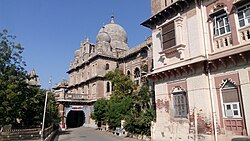
Vadodara, also known as Baroda, is the second largest city in the Indian state of Gujarat. It serves as the administrative headquarters of the Vadodara district and is situated on the banks of the Vishwamitri River, 141 kilometres (88 mi) from the state capital of Gandhinagar. The railway line and National Highway 8, which connect Delhi with Mumbai, pass through Vadodara. The city is named for its abundance of the Banyan (Vad) tree. Vadodara is also locally referred to as the Sanskari Nagari and Kala Nagari of India.
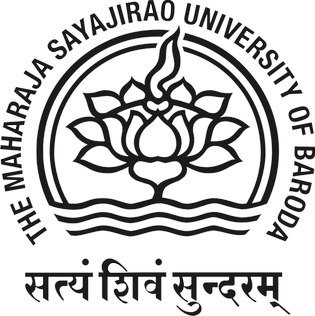
Maharaja Sayajirao University of Baroda, formerly Baroda College, is a public university in the city of Vadodara, Gujarat, India. Originally established as a college in 1881, it became a university in 1949 after India's independence. It was later renamed after its benefactor Maharaja Sayajirao Gaekwad III, the former ruler of Baroda State.

Mehsana, also spelled Mahesana, is a city and municipality in Mehsana district, in the Indian state of Gujarat. Established in 14th century, the city was under Gaekwads of Baroda State from 18th century to the independence of India in 1947. The municipality was established in 1919–20. The town has population of about 185,000. Dairy, oil and natural gas are major industries while there are several small and medium enterprises in the city.

Gaekwads, a Hindu Maratha dynasty of the former Maratha Empire and its subsequent (erstwhile) princely state of Baroda in western India from the early 18th century until 1947. The ruling prince was known as the Maharaja Gaekwad of Baroda. With the city of Baroda (Vadodara) as its capital, during the British Raj its relations with the British were managed by the Baroda Residency. It was one of the largest and wealthiest princely states existing alongside British India, with wealth coming from the lucrative cotton business as well as rice, wheat and sugar production.

Chamarajendra Wadiyar X was the twenty-third Maharaja of Mysore between 1868 and 1894.

Mehsana district is one of the 33 districts of Gujarat state in western India. Mehsana city is the administrative headquarters of this district. The district has a population of over 1.8 million and an area of over 4,500 km2. There are over 600 villages in this district with a population of 2,035,064 of which 22.40% were urban as of 2011.
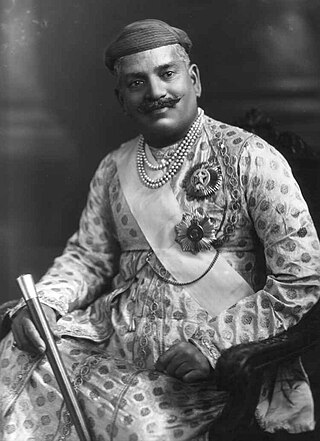
Sayajirao Gaekwad III was the Maharaja of Baroda State from 1875 to 1939, and is remembered for reforming much of his state during his rule. He belonged to the royal Gaekwad dynasty of the Marathas which ruled parts of present-day Gujarat.
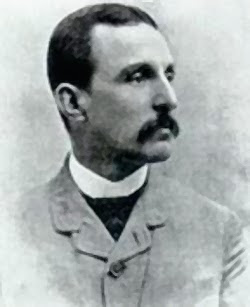
Frederick William Stevens was an English architectural engineer who worked for the British colonial government in India. Stevens' most notable design was the railway station Victoria Terminus in Bombay.

Idar State, also known as Edar, was a princely state located in present-day Gujarat state of India. During the British era, it was a part of the Mahi Kantha Agency, within the Gujarat Division of Bombay Presidency.
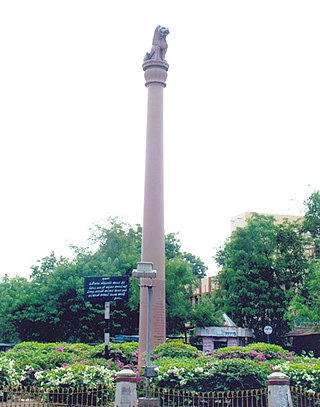
"Kirti Stambh", Tower of Fame/Triumph, is located in the city of Vadodara, Gujarat state, western India.
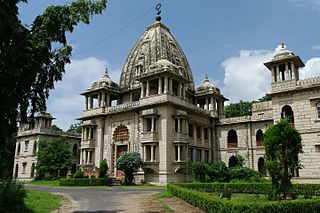
Kirti Mandir, or Temple of Fame, is the cenotaph of the Gaekwads, located in the city of Vadodara.

khanderao market is a famous and palatial building located in the city of Vadodara, Gujarat, in western India. It was erected by Maharaja Sayajirao Gaekwad III in 1906, named after Khande Rao Gaekwad, Maharaja of Baroda (1856–1870). It was presented by him as a gift to the Municipality to mark the Silver Jubilee of his administration. The offices of the Vadodara Municipal Corporation are located in this building. Fresh vegetable and flower market is also located in the back garden.
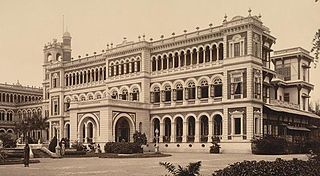
Makarpura Palace was a royal palace of Gaekwads of the Baroda State, in present-day Vadodara, Gujarat, India. It was built by Maharaja Khende Rao in 1870, in the Italian style. It was used as summer residence and hunting resort by the Royal Family.

Becharaji or Bahucharaji is a Hindu temple town and taluka capital in Mehsana district of Gujarat state, India. The temple of Hindu goddess Bahuchara Mata in the town is major pilgrimage centre.

Baroda State was a state in present-day Gujarat, ruled by the Gaekwad dynasty of the Maratha Confederacy from its formation in 1721 until its accession to the newly formed Dominion of India in 1949. With the city of Baroda (Vadodara) as its capital, during the British Raj its relations with the British were managed by the Baroda Residency. The revenue of the state in 1901 was Rs. 13,661,000. Baroda formally acceded to the Dominion of India, on 1 May 1949, prior to which an interim government was formed in the state.

The Katosan is a town and former Princely State in Jotana Taluka of Mehsana district, Gujarat, India.

Maharajkumar Shivajirao Gaekwad was an Indian first-class cricketer.
Sumant Mehta was a physician, independence activist and social worker from 20th-century India. Educated in London, he served as a personal physician of the Gaekwad rulers of Baroda State before entering public life in 1921. Along with his wife Sharda Mehta, he was involved in social and political activities.
The Architecture of Gujarat consists of architecture in the Indian state of Gujarat.

Boter Kothani Vav, also known as Mehsana Vav or Interi Vav, is a stepwell located in Mehsana, Gujarat, India.
